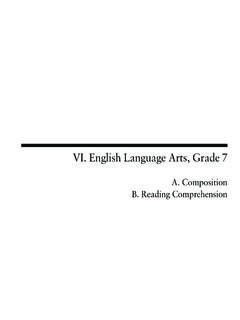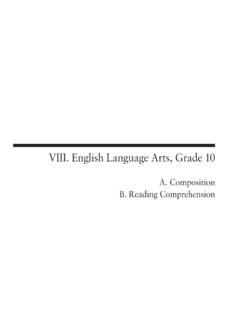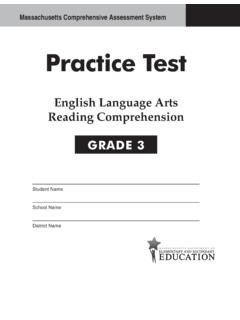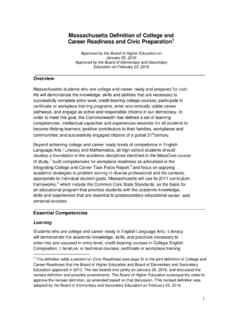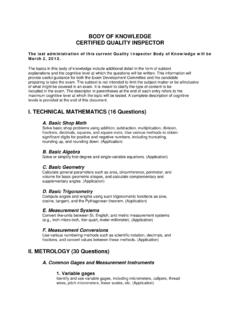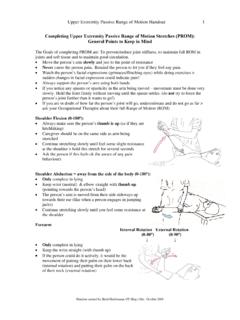Transcription of IV. English Language Arts, Reading …
1 IV. English Language arts , Reading comprehension , Grade 5. Grade 5 English Language arts Reading comprehension Test The spring 2015 grade 5 English Language arts Reading comprehension test was based on Pre-K 5. learning standards in two content strands of the Massachusetts Curriculum Framework for English Language arts and Literacy (March 2011) listed below. Page numbers for the learning standards appear in parentheses. Reading (Framework, pages 13 19). Language (Framework, pages 33 40). The Massachusetts Curriculum Framework for English Language arts and Literacy is available on the Department website at ELA Reading comprehension test results are reported under two MCAS reporting categories, Reading and Language , which are identical to the two framework content strands listed above.
2 The tables at the conclusion of this chapter indicate each released and unreleased common item's reporting category and the standard it assesses. The correct answers for released multiple-choice questions are also displayed in the released item table. Test Sessions and Content Overview The grade 5 ELA Reading comprehension test included two separate test sessions. Each session included Reading passages, followed by multiple-choice and open-response questions. Selected common Reading passages and approximately half of the common test items are shown on the following pages as they appeared in test booklets. Reference Materials During both ELA Reading comprehension test sessions, the use of bilingual word-to-word dictionaries was allowed for current and former English Language learner students only.
3 No other reference materials were allowed during any ELA Reading comprehension test session. 43. Grade 5 English Language arts Reading comprehension DIRECTIONS. This session contains two Reading selections with fifteen multiple-choice questions and two open- response questions. Mark your answers to these questions in the spaces provided in your Student Answer Booklet. Young drummer boys played an important role in the Civil War for both the Union (Northern) and Confederate (Southern) armies. Read the passage and answer the questions that follow. Drumbeats and Bullets from The Boys' War by Jim Murphy 1 T he groggy soldierwoke up to a persistent, brain-rattling drumming noise.
4 Thrump. Thrump. Thrump. He rolled over in an attempt to ignore the sound and pulled his blanket up over his head. The drumming went on and intensified as drummers all over camp signaled the call to There was no escaping it, and eventually and usually with a grumble the soldier got up to start another day. 2 Soldiers probably came to hate the sound of the drums, especially when they heard them on a drizzly, cold morning. Yet drummer boys who served during the Civil War provided valuable service to the armies of both sides, although some didn't realize it at first. 3 I wanted to fight the Rebs, 2 a twelve-year-old boy wrote, but I.
5 Was very small and they would not give me a musket. The next day I. went back and the man behind the desk said I looked as if I could hold a drum and if I wanted I could join that way. I did, but I was not happy to change a musket for a stick.. 4 This boy was disappointed at being assigned a nonfighting and, to him, dull job. Most likely, he saw himself always drumming in parades or in the safety of camp. He would soon learn differently. The drum corps of the Ninety-third New York Infantry. 1 muster to assemble troops 2 Rebs a nickname given to soldiers in the Confederate army 44. ELA Reading comprehension . 5 The beat of the drum was one of the most important means of communicating orders to soldiers in the Civil War.
6 Drummers did find themselves in camp sounding the routine calls to muster or meals and providing the beat for marching drills. But more often than not, they were with the troops in the field, not just marching to the site of the battle but in the middle of the fighting. It was the drumbeat that told the soldiers how and when to maneuver as smoke poured over the battlefield. And the sight of a drummer boy showed soldiers where their unit was located, helping to keep them close together. 6 Drummers were such a vital part of battle communication that they often found themselves the target of enemy fire. A ball3 hit my drum and bounced off and I fell over, a Confederate drummer at the Battle of Cedar Creek recalled.
7 When I got up, another ball tore a hole in the drum and another came so close to my ear that I heard it sing.. 7 Naturally, such killing fire alarmed many drummer boys at first. But like their counterparts with rifles, they soon learned how to face enemy shells without Fourteen-year-old Orion Howe was struck by several Confederate bullets during the Battle of Vicksburg in 1863. Despite his wounds, he maintained his position and relayed the orders given him. For his bravery, Howe would later receive the Medal of Honor. 8 Drumming wasn't the only thing these boys did, either. While in camp, they would carry water, rub down horses, gather wood, or cook for the soldiers.
8 There is even evidence that one was a barber for the troops when he wasn't drumming. After a battle, most drummers helped carry wounded soldiers off the field or assisted in burial details. And many drummer boys even got their wish to fight the enemy. 9 Fighting in the Civil War was particularly bloody. Of the 900 men in the First Maine Heavy Artillery, 635 became casualties in just seven minutes of fighting at the Battle of Petersburg. A. North Carolina regiment saw 714 of its 800 soldiers killed at Gettysburg. At such a time, these boys put down their drums and took up whatever rifle was Johnny Clem, twelve, handy.
9 One such drummer was Johnny Clem. just after the Battle of Shiloh, 1862. 3 ball a lead ball fired from a gun 4 flinching drawing away; falling back 45. ELA Reading comprehension . 10 Clem ran away from home in 1861 when he was eleven years old. He enlisted, and the Twenty-second Michigan Regiment took him in as their drummer, paying him thirteen dollars a month for his services. Several months later, at the Battle of Shiloh, Clem earned the nickname of Johnny Shiloh when a piece of cannon shell bounced off a tree stump and destroyed his drum. When another drum was shattered in battle, Clem found a musket and fought bravely for the rest of the war, becoming a sergeant in the fall of 1863.
10 11 The Civil War would be the last time drummer boys would be used in battle. The roar of big cannons and mortars, the rapid firing of thousands of rifles, and the shouts of tens of thousands of men made hearing a drumbeat difficult. More and more, bugles were being used to pass along orders. Military tactics were changing, too. Improved weapons made it impractical to have precise lines of soldiers face their enemy at close range. Instead, smaller, fast-moving units and trench warfare, neither of which required drummers, became popular. 12 Even as their role in the fighting was changing, Civil War drummers stayed at their positions signaling orders to the troops.



